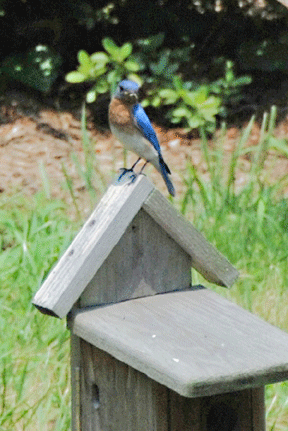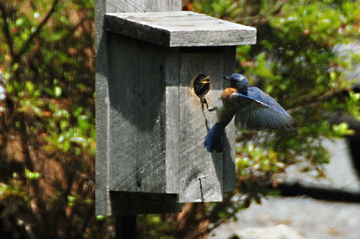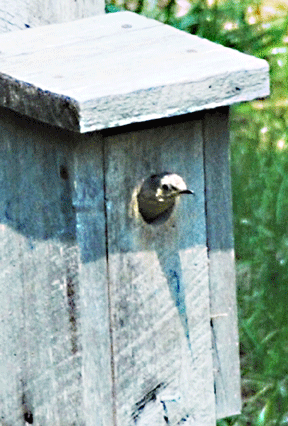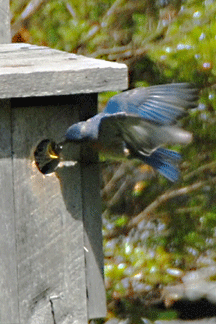
|
Volume XVII, Issue 13 - March 26 - April 1, 2009
|
|
Columns Reviews |
Our Bluebirds of Happiness
Would the birds brighten our lives — or be snake supper?
by Sandra Lee Anderson
Bluebirds are enshrined as life’s emissaries of happiness. But when husband Charlie volunteered to keep a bluebird trail at Jefferson Patterson Park, he learned a different story. He got to see life from the birds’ perspective — as a perilous enterprise where hope competes against the odds.
Every week for three seasons, Charlie has walked his adopted trail and opened each of 26 bluebird boxes. Part of his job is taking census, so he reaches in deep to touch the nestlings and eggs tucked into the nest.
I’m sure the bluebird parents flutter and quake nearby as Charlie inspects their young. He is too big for them to threaten; they can only watch and wait.
Do birds think the way we do? Do they feel as I would if our two-year-old grandson was threatened by a big monster — and I had to stand by idle?
Against the Odds
After two weeks in the egg, bluebirds emerge featherless with closed eyes. They soon become alert and crudely feathered. Ideally, in two to three more weeks, the now-adorable young birds will be fledged.

![]() But their short youth is perilous. Sometimes the nests of woven grasses and pine needles are full one week and empty the next. If young or eggs go missing, the predator was most likely a snake that swallowed them whole. If the empty nest is puffed up, with parts sticking out the entrance, then it was probably raided by a raccoon.
But their short youth is perilous. Sometimes the nests of woven grasses and pine needles are full one week and empty the next. If young or eggs go missing, the predator was most likely a snake that swallowed them whole. If the empty nest is puffed up, with parts sticking out the entrance, then it was probably raided by a raccoon.
After each brood has fledged, Charlie used a pancake turner to slide the old nest out of the box and clean out blowfly maggots — the young of another species that dine on the blood of the nestlings.
The first summer, only 16 boxes sheltered successful broods, yet some lucky parents reared two or three broods.
Winters are hard on all of us. One freezing winter a few years ago, caretakers opened the boxes to find the starved, frozen bluebirds huddled together. Last spring, Charlie brought great news: No frozen birds in any boxes. They had made it through.
Best Laid Plans
We had spent the gray months worrying. To get Charlie through the winter doldrums, I gave him a fancy bluebird box for Christmas. We hoped to entice bluebirds to bring their sunshine to our home.
Charlie pondered where to put his bird box. By April, he had settled on a spot at the edge of the woods where he could watch from his easy chair.
The box came with a pointed roofline, plastic viewing section and a screened bottom so the blowflies would drop out. It was an upscale home, sure to attract a bluebird couple. He mounted it on a metal garden post facing an open area near a bush, where fledglings could conveniently land.
Our first residents were chickadees. They are native and a protected species, so Charlie left them alone. They settled in, and things were going well until we saw the local Carolina wren emerging with an egg in its mouth.
It flew several feet from the house and dropped the egg. The wren dropped five eggs over two days, choosing a different drop site each time. The chickadees did not return, and we learned not to put a bird box near the woods.
Next, Charlie moved the bluebird box near the driveway, a spot where we could watch from the kitchen table.
Our first interested couple was again chickadees, which began nest building. Bluebirds came by later and also wanted the box. The male bluebird took a dive or two at the busy chickadee, which ignored him.

![]() We needed to be more resourceful. Charlie found a spare bluebird box at Battle Creek Cypress Swamp Nature Center, where boxes are stored for the trail keepers. This birdhouse was old with a flat roof and none of the other amenities. He posted the old birdhouse about 15 feet from the fancy one.
We needed to be more resourceful. Charlie found a spare bluebird box at Battle Creek Cypress Swamp Nature Center, where boxes are stored for the trail keepers. This birdhouse was old with a flat roof and none of the other amenities. He posted the old birdhouse about 15 feet from the fancy one.
For bluebirds, it’s the male’s job to locate a variety of homes. The female makes the final decision.
This female wanted the upscale home, but the chickadees were living there. The male made every effort to talk his wife into considering the old house. He flew by it; he perched on the flat roof; he hovered by the front door; he carried grass to the entrance to give her the hint.
The couple spent several weeks coming by. The male fluttered and flapped; the female watched as they discussed the pros and cons of the vacant home. She always perched on the peaked house while he looked at her from the old one. They finally settled somewhere else, and a healthy family of chickadees fledged.
Last spring, Charlie and I stood by the window watching for the new season’s drama. Our first residents were house sparrows, and they chose the old bird box. Since they are not native, Charlie removed the incomplete nests twice before the sparrows decided to build elsewhere.
A bluebird couple finally arrived to investigate the housing situation. The male fluttered and enticed his mate. This time they moved in — to the old square box. The fancy home remained vacant.
Raising a Family
 Each day, we watched from our kitchen table. The two birds flew in and out, building their nest. Then, across the driveway, the solitary male began to perch on a utility wire, a sentry watching the bird box. When another bird came too close, he flew at it, then returned to his post. The female exited occasionally.
Each day, we watched from our kitchen table. The two birds flew in and out, building their nest. Then, across the driveway, the solitary male began to perch on a utility wire, a sentry watching the bird box. When another bird came too close, he flew at it, then returned to his post. The female exited occasionally.
Charlie checked the nest and found five eggs. We waited for the young.
When the two parents commenced flying in and out of the hole, we knew the nestlings had hatched. Periodically during the day and into the evening, the two parents would sit together on the wire. The mother took to sitting on the wire more during the hot afternoons, allowing the chicks and herself to cool down.
The young decided to fledge as we were eating lunch with our grandson.
Each fledgling appeared, one at a time, with just a beak visible through the hole. It would retreat, then reappear a little farther out of the hole. Sometimes the father would flutter nearby, showing the young how to fly. Finally, the fledgling took the leap and, pounding its wings, made an ungainly flight focused on the bush, willing the newly feathered wings to keep up.
We watched through the afternoon and saw a couple of the nestlings fledge.
The Last Fledgling
By late afternoon, Charlie checked the birdhouse and reported one was still in there. We could see no sign of siblings or parents. I felt panic. Were the parents too busy feeding the other fledglings? Had they forgotten the last one? Charlie said he’d never found a box with just one dead baby in it. Slightly reassured, I continued watching until night fell.
 T
T![]() he next morning, nothing was happening at the box. We went through the hot day with no bluebird in sight. I worried.
he next morning, nothing was happening at the box. We went through the hot day with no bluebird in sight. I worried.
In the late afternoon, a beak emerged from the hole. Suddenly both parents were fussing around the entrance. The mother flew nearby. Chi-que chi-que chi-que she chattered, scolding the little one to come out. The parents gave it a little food. Finally, it screwed up its courage, took the plunge and, flapping wildly, followed a slightly downward course into the nearby bush.
The little one refused to budge from the bush. Both parents visited to cajole and encourage it, to no avail. It just hopped among the branches.
The father remained on the wire, continuing his guard duty into dusk. I assumed that the mother had tucked the other four on branches for thenight. The next day, the father was gone, as was the last fledgling.
Of course parents wouldn’t abandon the littlest one. Parents and grandparents just don’t do that.
One Small Victory
Charlie’s anticipated carefree hobby placed us squarely against the travails of nature. We overcame territorial wrens, bad locations and opportunistic chickadees to welcome bluebirds to our home. In the process, we found some of that elusive happiness.